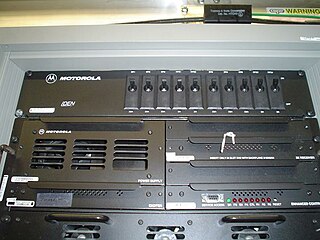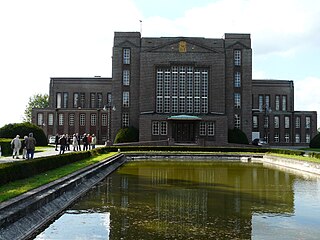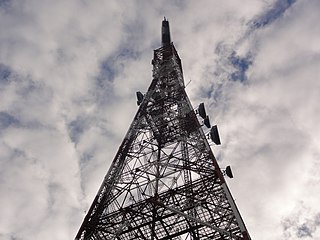Telecommunications in Sierra Leone include radio, television, fixed and mobile telephones, and the Internet.
JJY is the call sign of a low frequency time signal radio station located in Japan.
The Orfordness transmitting station was a major radio broadcasting facility at Orford Ness on the Suffolk coast in the United Kingdom able to broadcast to much of Europe. It closed in May 2012 after more than 30 years of service. In 2017 Radio Caroline started broadcasting from the site, though not with the same intended coverage of an audience in Europe as the original station.

The Croydon transmitting station is a broadcasting and telecommunications facility on Beaulieu Heights in Upper Norwood, London, England, in the London Borough of Croydon, owned by Arqiva. It was established in 1955 and initially used a small lattice tower. The present tower is 152 metres (499 ft) high and was built in 1962.
Radio masts and towers are typically tall structures designed to support antennas for telecommunications and broadcasting, including television. There are two main types: guyed and self-supporting structures. They are among the tallest human-made structures. Masts are often named after the broadcasting organizations that originally built them or currently use them.
A broadcast transmitter is an electronic device which radiates radio waves modulated with information content intended to be received by the general public. Examples are a radio broadcasting transmitter which transmits audio (sound) to broadcast radio receivers (radios) owned by the public, or a television transmitter, which transmits moving images (video) to television receivers (televisions). The term often includes the antenna which radiates the radio waves, and the building and facilities associated with the transmitter. A broadcasting station consists of a broadcast transmitter along with the production studio which originates the broadcasts. Broadcast transmitters must be licensed by governments, and are restricted to specific frequencies and power levels. Each transmitter is assigned a unique identifier consisting of a string of letters and numbers called a callsign, which must be used in all broadcasts.
A land mobile radio system (LMRS) is a person-to-person voice communication system consisting of two-way radio transceivers which can be stationary, mobile, or portable.

The Wenvoe transmitting station, officially known as Arqiva Wenvoe, is the main facility for broadcasting and telecommunications for South Wales and the West Country. It is situated close to the village of Wenvoe in the Vale of Glamorgan, Wales, in the UK.

The Fremont Point transmitting station is a facility for FM radio and television transmission at Fremont, Vingtaine du Nord, Saint John, Jersey.

A radio repeater is a combination of a radio receiver and a radio transmitter that receives a signal and retransmits it, so that two-way radio signals can cover longer distances. A repeater sited at a high elevation can allow two mobile stations, otherwise out of line-of-sight propagation range of each other, to communicate. Repeaters are found in professional, commercial, and government mobile radio systems and also in amateur radio.

The Strabane transmitting station is a broadcasting and telecommunications facility located at Legfordrum and situated very close to the town of Strabane, in County Tyrone, Northern Ireland. It is owned and operated by Arqiva.
The Oxford transmitting station is a broadcasting and telecommunications facility, situated on land 129.5 metres (425 ft) above Ordnance Datum to the north east of the city of Oxford, in Oxfordshire, England. It has a guyed steel lattice mast which is 154.4 metres (507 ft) in height to the top of the main steel structure. The UHF television antenna, which consist of a vertical array of transmitting panels, is mounted above the steel structure. The total height of the mast to the top of this UHF antenna is 165.7 metres (544 ft). It is owned and operated by Arqiva.

Mass media in Sierra Leone began when the first modern printing press in Africa arrived at the start of the 19th century. In the 1860s the country became a journalist hub for Africa with professional travelling to the country from across the continent. At the end of the 19th century the industry went into decline and when radio was introduced in the 1930s this became the primary communication media. Print media is not widely read in Sierra Leone, especially outside Freetown, partially due to the low levels of literacy in the country. In 2008 there were 15 daily newspapers in addition to those published weekly. Among newspaper readership young people are likely to read newspapers weekly and older people daily. The majority of newspapers are privately run and are often critical of the government.

Nauen Transmitter Station in Nauen, Havelland district, Brandenburg, Germany, is the oldest continuously operating radio transmitting installation in the world. Germany's first high power radio transmitter, it was founded on 1 April 1906 by Telefunken corporation and operated as a longwave radiotelegraphy station through World War II, and during World War I became Germany's main link with the outside world when its submarine communications cables were cut. Upgraded with shortwave transmitters in the 1920s it was Germany's most advanced long range radio station, continually upgraded with the latest equipment and serving as an experimental station for Telefunken to test new technology. At the end of World War II, invading Russian troops dismantled and removed the transmitting equipment. During the Cold War it served as the GDR's international shortwave station Radio Berlin International (RBI), and was the East Bloc's second most powerful radio station, disseminating Communist propaganda to other countries. Since German Reunification in 1991 it has been operated by Deutsche Telekom, Germany's state telecommunication service. The original 1920 transmitter building designed by architect Herman Muthesius is still used; it is the only remaining building designed by that architect.
Capital Radio is a Sierra Leone radio station based at the Mammy Yoko Business Park in Aberdeen, Freetown.

Antenna farm or satellite dish farm or just dish farm are terms used to describe an area dedicated to television or radio telecommunications transmitting or receiving antenna equipment, such as C, Ku or Ka band satellite dish antennas, UHF/VHF/AM/FM transmitter towers or mobile cell towers. The history of the term "antenna farm" is uncertain, but it dates to at least the 1950s.
The Sierra Leone Broadcasting Corporation (SLBC) is the national radio and television broadcaster in Sierra Leone. It is owned by the government of Sierra Leone and is a branch of the Sierra Leone Ministry of Information and Communications. It is theoretically regulated by the Independent Media Commission (IMC). The SLBC primarily broadcasts the national television and regional radio service from its headquarters in the New England neighborhood of Freetown. Regional stations provide FM radio services in Bo, Kenema, Kailahun, Makeni, Magburaka and Koidu.

A transmitter station or transmission facility is an installation used for transmitting radio frequency signals for wireless communication, broadcasting, microwave link, mobile telephone or other purposes.

The Millennium Transmitter is a 720 ft (219.5 m) tall mast owned by ABS-CBN Corporation and operated by Advanced Media Broadcasting System located at the ABS-CBN Broadcasting Center, Mother Ignacia Street corner Sgt. Esguerra Avenue, Barangay South Triangle, Quezon City. Since September 13, 2022, the transmitter is being used by AMBS to serve as the platform for television transmission of ALLTV on analog Channel 2 and digital Channel 16. It was also used as the main transmission site for ABS-CBN-owned DWAC-TV Channel 23, the flagship station of ABS-CBN Sports and Action, before shutting down in 2020 and its frequency reassigned to Aliw Broadcasting Corporation and its radio station DWRR until it was relocated to Antipolo when the transmitter was upgraded by the end of 1999.

Divis transmitting station is the main high-power UHF and BBC National FM/DAB station that serves County Antrim and parts of County Down.














